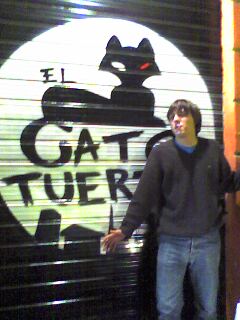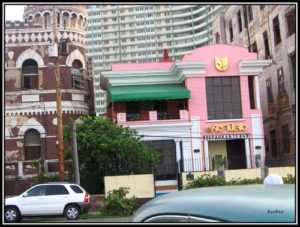“EL GATO TUERTO” HABANERO, WAS AND SHALL BE, A PLACE “WHERE TO START AND END THE DAY IS A PLEASURE”.
Before 1959, “El Gato Tuerto” (The One-Eyed Cat) was one of two bars-piano-restaurant in Havana that were open 24 hours a day.
Both ‘Bigote de Gato’ and ‘El Gato Tuerto’ were, apart from Floridita and La Bodeguita del Medio, the only locals who saw sunrise in the Cuban capital. Gato Tuerto also had other attractions: for example, that his bartender was an artist. Not only serving cocktails, but with the trumpet that, at the pace that was needed, played behind the bar. Everything a luxury.
In the Tuerto Cat there is a night inside / with a moon that goes out for some, / and a sun that shines for others … “This was what the Cuban poet and playwright Virgilio Piñera said, who years ago portrayed what was. He was born ‘El Gato Tuerto’ with the legend on the back of two Spaniards facing each other for having the best bar in Havana. For “Cat Tuerto” and “Bigote de Gato”, the two compatriots, it was a question of honor who prepared the best cocktail or achieved the most complete “download” of artists.
Sometimes the owner delighted the clientele with their trumpet solos and over time, the club began to attract musicians and artists of all kinds. But it was the charismatic editor and cultural promoter Felito Ayón (who rubbed shoulders with the bohemian artists of Havana) who made the Tuerto Cat notorious, making it an intimate, glamorous and select place, a favorite place for Havana’s intellectuals Night. The place was renovated and when it reopened on August 31, 1960, it was already famous for being the place to enjoy the best “filin”.
Located very close to the Hotel Nacional de Cuba and El Malecón, “El Gato Tuerto” is a historic bar that has retained all its character and charm, and without doubt one of the musical poles of Havana night. It is one of those places where time seems to have stopped years ago, when everything was simpler and people were not in such a hurry. Although time has turned it into a nostalgic memory.
Almost all the philanthropic voices were passed by Gato: Elena Burke, Moraima Secada, Lino Borges, José Antonio Méndez, Bobby Jiménez, Vilma Valle, Raul Acosta, Doris de la Torre, Frank Dominguez, and others.
Re-inaugurated on August 31, 1960, based on the original project of the Spanish artist Felito Ayón, who for the knowledge of all was one of the founders of La Bodeguita del Medio in the 1950s, the Concert Bar “El Gato Tuerto” Has now returned to unite the bohemian habanera, the fashionable singers, the painters who exhibit on their walls, all inspired by their environment complicit and excellent cuisine, where each dish is also a song or a poem.
The works of Cuban painters such as Amelia Peláez, Raúl Acosta Leon, Mariano Rodríguez, Luis Mariano Pedro, Alberto Falcón, Tomás Marai and Raúl Tapia, who once adorned the walls of ‘El Gato Tuerto’, now join in the Of Zaida del Río or Nelson Domínguez, in the rescue of the tradition of being a place where all the cultural manifestations fit. It is still heard there to the inimitable Juana Bacallao, as one day they heard there the unforgettable chords of Benny Moré, Elena Burke, Omara Portuondo, César Portillo de la Luz or José Antonio Méndez, many of them accompanied at the piano by the prodigious Frank Emilio.
‘El Gato Tuerto’ and its founders leave Cuba.
But as all that begins ends and although marveling at the atmosphere and the Cuban night, the owners of Gato Tuerto decided to export the concept to their old Spanish homeland and, after forty years of travel in Cuba, the first Spanish store opened its doors in The town of Pola de Siero. It was the year 2000. It was not a simple task to adapt the spirit of Havana to the new place, but it was achieved: remodeling an old building in Los Peligros street, recovering materials such as wood, stone, plaster, furniture bottles … and, most importantly, the good cocktails were joined by the live musical performances.
Then, the third great date of this history was constituted in the year 2006, in which the third Gato Tuerto, the local of Gijón, was born that supposed the implementation of a system of franchises. The concept that had worked in Cuba now also had Spain, particularly Asturias, so the chain’s plans are ambitious. The objective is to export the idea, through the franchise system, to all Spain but, as they themselves state, that “is another story …”
Documentary of “El Gato Tuerto”.
It has been a famous historical project of piano-bar-restaurant, now international, that has made a documentary feature “El Gato de La Habana”, dedicated to the emblematic cat-bar Gato Tuerto, and that in these days has been restructured in Cuba.
The three ship of the Cuban Art Factory hosted the reissue of ‘El Gato de La Habana’, the documentary that shows a deep research work undertaken by the Brazilian journalist and documentalist Dacio Malta, attracted by the fact that in Cuba they do not exist books or movies about such an attractive place. ‘El Gato de La Habana’ was revived in Cuba at the Art Factory, after touring various festivals in the United States, Europe and Latin America and premiered at the last International Festival of New Latin American Cinema.
“EL GATO TUERTO” HABANERO, QUE FUÉ Y SERÁ, UN LUGAR “DONDE EMPEZAR Y ACABAR EL DÍA ES UN PLACER”.
Antes de 1959, “El Gato Tuerto” era uno de los dos bares-piano-restaurant en La Habana que se mantenían abiertos las 24 horas.
Tanto ‘Bigote de Gato’ como ‘El Gato Tuerto’ eran, aparte de Floridita y La Bodeguita del Medio, los únicos locales que veían amanecer en la capital cubana. Gato Tuerto tenía además otros atractivos: por ejemplo, que su barman era un artista. No sólo sirviendo cócteles, sino con la trompeta que, al ritmo que fuese menester, tocaba detrás de la barra. Todo un lujo.
En el Gato Tuerto hay una noche dentro de la noche/ con una luna que sale para algunos,/ y un sol que brilla para otros…” Así decía el teatrista y poeta cubano Virgilio Piñera, quien hace años retrató lo que fue. Nació ‘El Gato Tuerto’ con la leyenda a cuestas de dos asturianos enfrentados entre sí por tener el mejor bar de La Habana. Para “Gato Tuerto” y “Bigote de Gato”, los dos compatriotas, era cuestión de honor quién preparaba el mejor cóctel o lograba la más completa “descarga” de artistas.
A veces, el dueño deleitaba a la clientela con sus solos de trompeta y con el tiempo, el club empezó a atraer a músicos y artistas de toda clase. Pero fue el carismático editor y promotor cultural Felito Ayón (quien se codeaba con los artistas bohemios de La Habana) el que le dio notoriedad al Gato Tuerto, convirtiéndolo en un lugar íntimo, glamoroso y selecto, lugar preferido por la intelectualidad habanera para sus reuniones nocturnas. El lugar fue remozado y cuando volvió a abrir sus puertas el 31 de agosto de 1960, ya era famoso por ser el lugar preferido para disfrutar del mejor “filin”.
Situado muy cerca del Hotel Nacional de Cuba y de El Malecón, “El Gato Tuerto” es un bar histórico que ha conservado todo su carácter y encanto, y sin duda uno de los polos musicales de la noche habanera. Es uno de esos sitios donde parece que el tiempo se haya detenido años atrás, cuando todo era más sencillo y la gente no tenía tanta prisa. Aunque el tiempo lo haya convertido en un nostalgico recuerdo.
Por el Gato pasaron casi todas las voces filineras: Elena Burke, Moraima Secada, Lino Borges, José Antonio Méndez, Las Capellas, Bobby Jiménez, Vilma Valle, Raúl Acosta, Doris de la Torre, Frank Domínguez, y otros.
Re-inaugurado el 31 de agosto de 1960, a partir de ese proyecto original del español Felito Ayón, que para conocimiento de todos fue uno de los fundadores de La Bodeguita del Medio en la década de 1950, el Bar Concert “El Gato Tuerto” ha vuelto ahora a aglutinar a la bohemia habanera, a los cantantes de moda, a los pintores que exponen en sus paredes, todos inspirados por su ambiente cómplice y por una excelente cocina, donde cada plato es también una canción o un poema.
Las obras de pintores cubanos como Amelia Peláez, Raúl Acosta León, Mariano Rodríguez, Luis Mariano Pedro, Alberto Falcón, Tomás Marai y Raúl Tapia, que un día adornaron las paredes de ‘El Gato Tuerto’, se unen ahora en la historia a las de Zaida del Río o Nelson Domínguez, en el rescate de la tradición de ser un lugar donde caben todas las manifestaciones culturales. Todavía se sigue escuchando allí a la inimitable Juana Bacallao, como un día se oyeron allí los acordes del inolvidable Benny Moré, Elena Burke, Omara Portuondo, César Portillo de la Luz o José Antonio Méndez, muchos de ellos acompañados al piano por el prodigioso Frank Emilio.
‘El Gato Tuerto” y sus fundadores salen de Cuba.
Pero como todo lo que empieza termina y aunque maravillados por el ambiente y la noche cubana, los propietarios de Gato Tuerto decidieron exportar el concepto a su vieja patria española y, tras cuarenta años de andadura en Cuba, el primer local español abría sus puertas en la localidad de Pola de Siero. Corría el año 2000. No era una tarea sencilla adecuar el espíritu de La Habana al nuevo local, pero se conseguía: se remodelaba un viejo edificio de la calle Los Peligros, se recuperaban materiales como las maderas nobles, piedra, estucados, muebles botelleros… y, lo más importante, a los buenos cócteles se le unían las actuaciones musicales en directo.
Después, la tercera gran fecha de esta historia la constituyó el año 2006, en el que nacía el tercer Gato Tuerto, el local de Gijón, que suponía la puesta en marcha de un sistema de franquicias. El concepto que habia funcionado en Cuba ahora lo tenia tambien España, en particular Asturias, por eso los planes de la cadena son ambiciosos. El objetivo, exportar la idea, mediante el sistema de franquicias, a toda España pero, como ellos mismos manifiestan, ésa “es otra historia…”
Documental de “El Gato Tuerto”.
Ha sido tan famoso historico proyecto de piano-bar-restaurant, hoy ya internacional, que se ha hecho un largometraje documental “El Gato de La Habana”, dedicado al emblemático piano-bar Gato Tuerto, y que en estos dias se ha reestrenado en Cuba.
La nave tres de la Fábrica de Arte Cubano acogió el reestreno de ‘El Gato de La Habana’, el documental que muestra un profundo trabajo de investigación emprendido por el periodista y documentalista brasileño Dacio Malta, atraído por el hecho de que en Cuba no existen libros ni películas sobre un lugar tan atractivo. ‘El Gato de La Habana’ se reestrenó en Cuba, en la Fábrica de Arte, luego de recorrer diversos festivales en Estados Unidos, Europa y Latinoamérica y estrenado en el pasado Festival Internacional del Nuevo Cine Latinoamericano.
Agencies/Wiki/Various/Internet Photos/YouTube/ Arnoldo Varona/ TheCubanHistory.com
THE CUBAN HISTORY, HOLLYWOOD.










